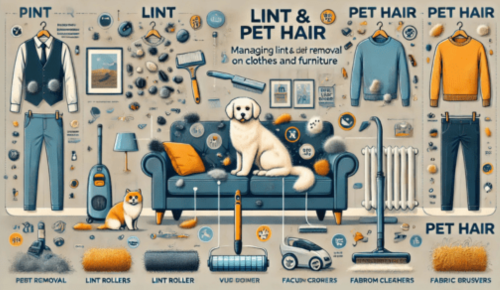If you have pets, you know that keeping your clothes and furniture free from hair and lint can be an endless struggle. Pet hair often clings to fabrics, and when combined with lint, it can create a stubborn mess. Whether you have a cat, dog, or any furry companion, learning how to manage pet hair and lint in your laundry and home can make a big difference in maintaining a clean, comfortable living environment. This article will cover how lint and pet hair interact, as well as the best practices and tools for keeping your clothes and furniture clean.
Why Pet Hair and Lint Are a Problem
Pet hair can be notoriously difficult to remove from fabrics, especially when it’s combined with lint. Both pet hair and lint have similar properties—they are lightweight and can become trapped in fibers of clothing or furniture. The static electricity in the air, particularly in dry environments, contributes to this issue, causing both pet hair and lint to cling to fabrics.
Pet hair is more likely to stick to certain fabrics, like fleece, wool, and cotton, which also shed fibers and attract lint. As a result, you may find that your favorite sweater or blanket not only accumulates lint but is also covered in hair from your beloved pet.
To tackle this challenge, it’s important to combine both lint and pet hair management. For a better understanding of how lint forms and accumulates on clothes and furniture, check out this guide on managing lint.
Laundry Tips to Combat Pet Hair and Lint
Managing both pet hair and lint starts in the laundry room. Here are several strategies to reduce hair and lint buildup in your wash:
- Pre-Treat with a Lint Roller or Brush
Before putting your clothes or blankets in the wash, use a lint roller or a pet hair brush to remove as much pet hair as possible. This step helps prevent hair from spreading throughout the laundry load. - Use a Dryer Sheet or Fabric Softener
Dryer sheets and fabric softeners can help reduce static electricity, which is responsible for making both lint and pet hair cling to fabrics. Adding one or two sheets to your dryer load can minimize the amount of lint and pet hair that sticks to your clothes. - Dry Clothes with a Dryer Ball
Dryer balls can be a great tool to help reduce pet hair and lint on clothes. These balls help agitate your laundry as it tumbles, preventing pet hair from clumping and making it easier for lint to fall off. Wool dryer balls are particularly effective at catching and reducing lint buildup. - Wash with Cold Water
Using cold water to wash clothes can reduce friction, which minimizes the shedding of both pet hair and fibers that cause lint. Additionally, cold water helps prevent static buildup, which is a key factor in the attraction of lint and hair to fabrics. - Wash Pet Bedding and Toys Separately
Pet bedding and toys are prime sources of pet hair, so it’s best to wash them separately from your regular laundry. This minimizes the transfer of hair and lint to your other clothes.
For further information on how to handle lint buildup on blankets and towels, check out this guide on managing lint in laundry.
How to Remove Pet Hair and Lint from Furniture
Pet hair can be just as much of a problem on furniture as it is on clothing. Here are a few tips to help you remove pet hair and lint from your couches, chairs, and other fabric surfaces:
- Use a Vacuum with a Upholstery Attachment
One of the most effective ways to remove pet hair and lint from furniture is to use a vacuum cleaner with an upholstery attachment. The attachment’s suction power can remove hair and lint from even the toughest fabrics. Be sure to clean your vacuum regularly to maintain its effectiveness. - Rubber Gloves for Pet Hair Removal
Another simple tool to use on furniture is rubber gloves. Lightly dampen the gloves and run them over your furniture. The friction will cause pet hair to stick to the gloves, which you can then easily wipe off. - Lint Roller for Furniture
A lint roller isn’t just for clothes—it’s also great for picking up pet hair and lint from furniture. Simply roll it over the fabric to collect hair and debris. - Fabric Brush
A fabric brush designed to remove pet hair and lint can be an excellent tool for getting rid of stubborn debris. Use the brush in short strokes to gently lift pet hair from furniture.
Preventing Pet Hair and Lint Buildup in Your Home
Prevention is key when it comes to managing pet hair and lint around the home. Here are a few strategies to keep both in check:
- Groom Your Pet Regularly
Regular brushing and grooming can help reduce the amount of hair your pet sheds. Consider using a de-shedding brush to remove loose fur before it gets onto your furniture or clothing. - Use Furniture Covers
If your pet loves lounging on your furniture, consider using washable furniture covers or slipcovers. These can be easily removed and cleaned, helping you keep lint and pet hair off your couches and chairs. - Air Purifiers
An air purifier can help reduce pet hair and lint in the air, preventing it from settling on surfaces. Make sure to regularly clean the filters to maintain optimal performance.
For additional tips on cleaning pet hair and lint from your home, including the best products for dealing with both, refer to this detailed guide.
Conclusion
Lint and pet hair can be a major source of frustration, especially when they seem to accumulate in every corner of your home. However, with the right practices, tools, and a little bit of effort, it’s possible to keep your clothes and furniture clean. By following the laundry tips and home-cleaning methods mentioned above, you can enjoy a cleaner, lint- and pet-hair-free environment.





